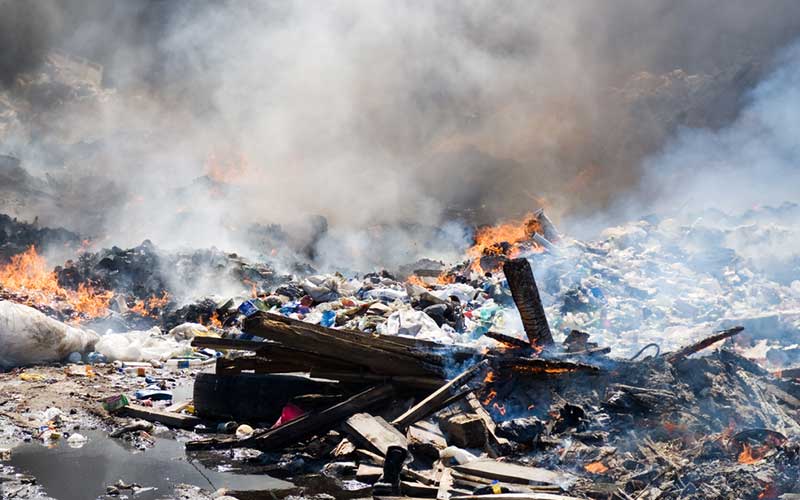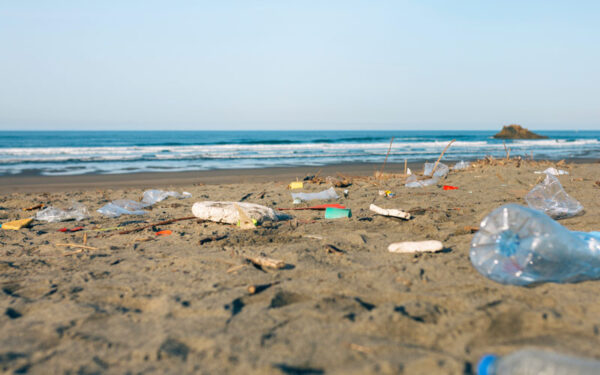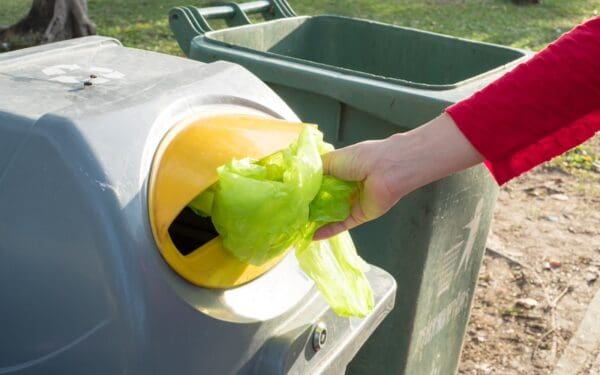
Burning trash to create energy will not solve our growing waste problem or the climate crisis. Photo: Shutterstock
For centuries we’ve relied on landfilling as our main source of waste disposal. In fact, the U.S. landfilled about 139 million tons of trash in 2017 alone. But there’s another form of disposal that the U.S. has consistently used since the 1880s – incineration.
Incineration was originally thought of as another way to “get rid of” trash (it doesn’t, really). But in recent years, it has been falsely rebranded as a sustainable source of “clean” energy. What’s more, industry hacks claim that their so-called “waste-to-energy” technologies can help combat the climate crisis by reducing climate-damaging emissions like methane and carbon dioxide.
But these claims are misleading and inaccurate, and allow for waste incinerators to devour renewable energy subsidies that should be reserved for real sources of sustainable energy.
“New” incineration technologies – high-heat treatments like gasification and pyrolysis – are actually a really dirty business. Not only do they endanger our health and the environment, but they also generate little energy as compared to cleaner sources. And, they inhibit efforts to reduce our overall waste, which would be much more effective in cutting climate-damaging emissions.
Simply put, burning trash to create energy will not solve our growing waste problem or the climate crisis.
Energy Generated from Trash is Just Dirty Energy
The idea behind high-heat gasification and pyrolysis technologies is to expose trash to high temperatures with little to no oxygen. This process creates a synthetic fuel that is then burned in an oxygen-rich environment to produce energy – or “dirty” energy in this case.
These technologies were originally designed to treat fuel sources like wood or coal. But as the production of cheap goods continues to snowball and concerns around the climate crisis grow, waste management companies across the U.S. are starting to consider using them to “get rid of” our trash. But unlike wood or coal, our trash is anything but uniform.
Think about it. What do you typically throw away? If I had to guess, I’d say you toss out a wide array of items – food scraps, old cleaning products, non-recyclable plastic packaging, expired medicine, old clothes, and so much more. Combined, it’s a pretty foul mixture of materials and chemicals – a mixture that I certainly wouldn’t want to touch, let alone burn for energy.
Production of Dirty Energy Expels Toxic Pollution
Burning such a varied mix of materials comes with consequences. Industry claims new gasification and pyrolysis technologies are less polluting than “old” technologies like mass-burn incineration, which is the toxic technology used in Saugus, Massachusetts, and other New England communities. These older incinerators emit higher concentrations of dangerous pollutants than coal-fired power plants. Some backers even claim that gasification and pyrolysis release zero emissions.
But the truth is that burning anything creates air pollution and ash. So, when you burn toxic trash, no matter which technology you use, you’re going to release harmful emissions into the air.
What’s more, just because you burn something toxic doesn’t mean you eliminate the poison – it just changes form. The synthetic fuel produced at these gasification and pyrolysis facilities is still contaminated with dangerous chemicals. And when that synthetic fuel is burned for energy, it in turn, discharges high levels of dioxin, mercury, and other toxic pollutants – in amounts even higher than fracked gas, diesel, and gasoline.
These emissions not only put our physical health at risk but also pollute our environment and contribute to the climate crisis.
Dirty Energy Technology is a Waste of Energy
While the waste industry claims that burning trash for energy using this “new” incineration technology can help the world reach its goal of net-zero carbon emissions, their reasoning is weak. They assert that by burning trash instead of landfilling it, they are helping to reduce, if not avoid, landfill emissions like methane – emissions that damage our climate. But the methane produced at landfills is largely due to organic materials like food scraps and yard clippings – materials that would conserve more energy, and serve as a carbon sink, if composted.
In fact, we can conserve more energy by composting, recycling, and redesigning products than can be generated through high heat incineration technologies. Plus, these zero waste alternatives come with far fewer health risks and climate-damaging emissions than dirty energy.
Dirty Energy Threatens Efforts to Reduce Waste – and It Costs Us Money
The waste industry will argue that our trash has to go somewhere, so why not burn it for energy? But as incineration relies on a constant flow of waste – including items that could and should be composted or recycled – it competes with real solutions that are better for our health and the environment.
What’s more, incineration is expensive. Gasification and pyrolysis facilities use a massive amount of energy to operate – which doesn’t come cheap. That, along with steep building and operating costs, means that these plants are not practical investments. Yet because we continue to rely on incineration as a means for disposing of our waste, the financial burden of these facilities will get passed on to cities, towns, and businesses.
We don’t need to burn our trash. The best way to “deal” with our waste – and save money – is to not produce so much in the first place. And we can do that by setting up new systems directly aimed at reducing our trash, redesigning our products, and composting food and yard waste.
By adopting zero waste solutions, not only will we cut climate-damaging emissions and protect our communities, but we’ll save money and generate a thriving green economy that operates on true sources of clean energy.




